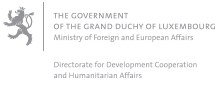- Home
- Preface
- I. Luxembourg’s official development assistance in 2014
- 2015 – European Year for Development
- Multilateral cooperation commitments in the health sector
- Action plan for development effectiveness 2014-2016
- II. Cooperation with the main partner countries
- III. Regional cooperation and cooperation with other countries
- IV. Multilateral cooperation
- V. European Union
- VI. Cooperation with non-governmental development organisations
- VII. Humanitarian action
- VIII. Programme support
- IX. Development education and awareness raising
- X. Microfinance
- XI. Evaluation
- XII. Report on the progress of the work of the Interministerial Committee for Development Cooperation
- Appendices
VII. Humanitarian action

emergency.lu - Rollout in the Philippines following typhoon Haiyan
emergency.lu
In November 2013, emergency.lu was rolled out for the first time in response to a large-scale natural disaster following typhoon Haiyan in the Philippines. Four terminals and 6 volunteers were rushed to the scene, both at the request of the ETC (Emergency Telecommunications Cluster) and as part of an IHP (International Humanitarian Partnership) mission to support the OCHA. Thus the emergency.lu telecommunications systems provided connectivity to thousands of humanitarian workers, especially in December 2013 and January 2014. The system installed on the roof of Tacloban town hall alone provided free connectivity to hundreds of humanitarian workers sheltering in the stadium, the UN coordination unit, the town hall and the airport. The last emergency.lu kit, installed in the camp in Guiuan was dismantled at the end of May 2014.
During the week of 7 - 11 April, representatives of the United Nations, the Luxembourg government, the private sector, non-governmental organisations and other interested parties met in Luxembourg as part of the Humanitarian Week of Information and Communication Technologies (ICT) in order to discuss the contribution of new technologies to disaster response. During that week, the ETC held its plenary meeting for the first time in Luxembourg. The members of the ETC drew up an initial draft of the cluster’s 2020 Vision and discussed the challenge of offering connectivity to governments and communities affected by a disaster rather than, as at present, focusing on the communication needs of humanitarian organisations.
In May, two new systems were deployed in South Sudan, while the equipment that had been used there since January 2012 was repatriated for maintenance. A short time later, one of these systems was installed in Mingkaman in a camp that had just been opened to shelter people who had fled inter-ethnic violence in the Bor region.
In October, Luxembourg became a member of the IHP, a European network of civil protection units which specialises in providing United Nations humanitarian agencies with emergency equipment and staff in the event of a disaster.
In November, five emergency.lu project systems were sent to West Africa to provide communications services to the organisations involved in combating the Ebola epidemic. At the end of December, three systems were operational (two of them in the camps established by IHP in Port Loko and Moyamba in Sierra Leone with the support of the ETC, and one terminal providing connectivity for the Belgian laboratory B-LiFE in Guinea). Two systems were on standby in Accra.
Furthermore, as every year, civil protection volunteers participated in many exercises and simulations at the European and international level, using and testing the emergency.lu solution.
In 2014, a total amount of 4 128 630,72 euros was spent from the DCF on the final year of the initial contract of the emergency.lu project (2011-2014).
Added to this is an amount of 149 044,14 euros spent on operational costs, especially the costs of transporting the equipment and expenses connected with the missions and exercises.
On 19 December, Minister Romain Schneider signed the contract to extend the emergency.lu project for the 2015-2020 period with the private partners SES TechCom, Hitec Luxembourg and Luxembourg Air Ambulance. At the same time, he signed a new collaboration agreement with the freight forwarder Schenker Luxembourg.

